Lions, leopards, elephants, zebras, giraffes, hippos, cheetahs and more, much more. That’s what you can expect as far as wildlife on a photo safari in the Serengeti. But what’s it like getting there, getting around, where do you stay, what do you eat, what do you do each day, etc.? I’ve just returned from leading my tenth safari to Tanzania (where Serengeti National Park is), and while I’ve written many stories about the photography there (including this one), this time I’m going to take you through the trip, day by day.
Day One
Leave home. The two most common ways to get to Kilimanjaro Airport (JRO, the closest international airport to the Serengeti) are with Delta/KLM through Amsterdam or United/Ethiopian Airlines through Addis Ababa. As a long-time United flier, I opt for that second one, which means I fly from Kansas City to Chicago, then to Addis Ababa and from there to Kilimanjaro Airport (near Arusha, TZ). Yes, it’s a long trip, but it’s one of those times where the reward is worth the suffering. Or, if you’ve got the money or miles, fly Business Class. Me, I’m in Economy, and watch a lot of movies.
Day Two
Arrive in Tanzania. Passport and visa in hand (which you can – and should – do over the internet ahead of time), get off the plane and hustle. The sooner you get to the Immigration/Customs windows, the sooner you’ll get your luggage and get out of the airport, where one of the guides (we usually have three) will be waiting. Exhausted from the trip, I like to take a nap as soon as I get to the hotel, then spend the rest of the afternoon outside, to start adjusting to the time change (8 hrs for me).
Day Three
I always fly in a day early (ahead of when the safari starts) as insurance against travel delays. Many in my group do that as well, so instead of sitting around the hotel, I arrange for our guides to take us to Arusha National Park. About an hour’s drive away it’s a great warm-up for the main safari. Plus, it’s the only place where we’ll be able to do a “walking” safari (the rest of the time we’ll be in trucks). Joining a park ranger, he’ll take us out into the bush for about two hours where we’ll usually see giraffes, cape buffalo, wildebeest or zebra and birds.
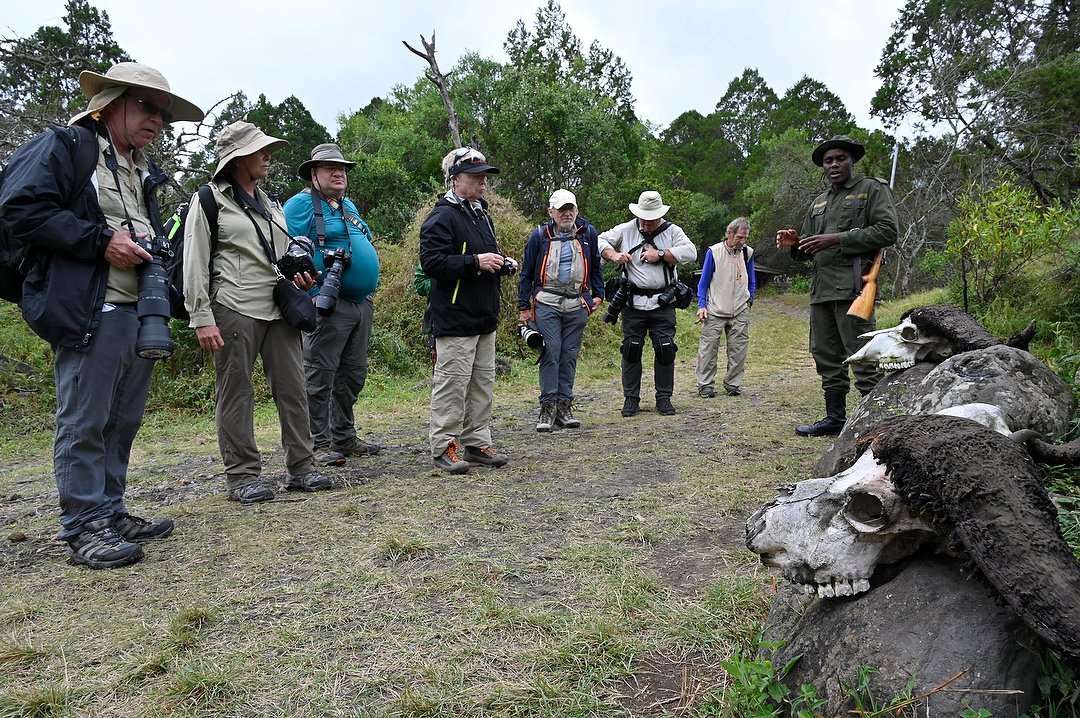
Here’s the members of my group that arrived a day early, about to start a walking safari with a ranger in Arusha National Park. Using the row of skulls at the right, he’s telling us about the animals we can expect to see.
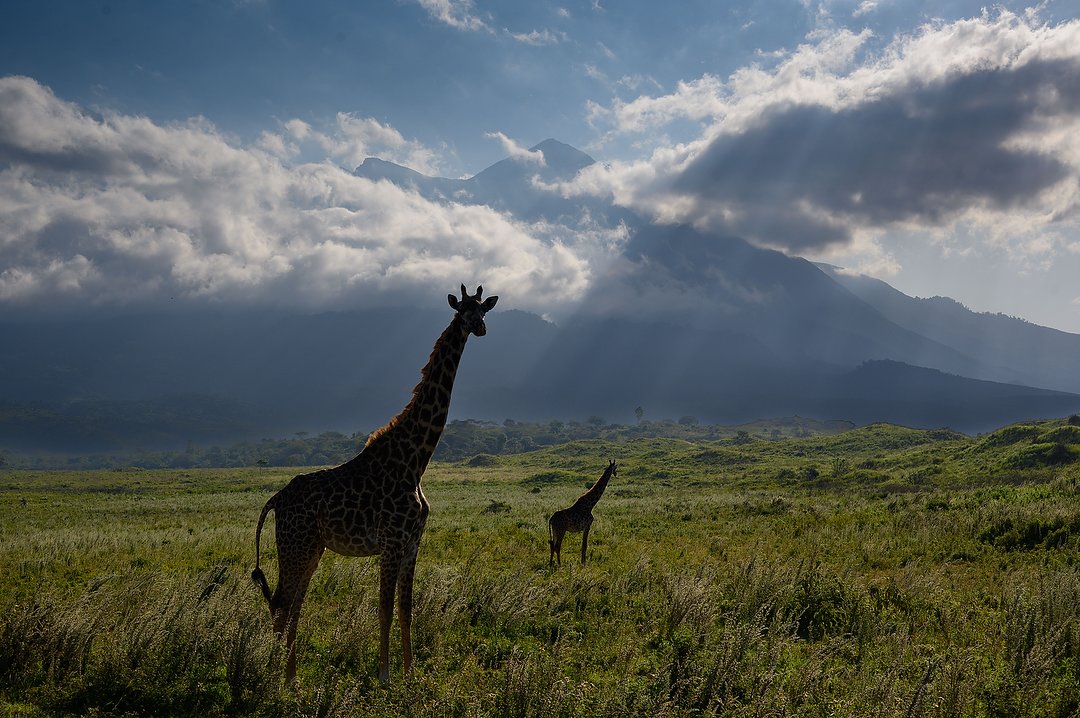
Standing just thirty yards from a giraffe, in the wild, is a pretty neat experience This is what makes the walking safari special. Nikon Z 6 II, Aperture Priority, Natural auto white balance, ISO 250, 1/1600 at f/9 in Matrix metering, -0.7 EV, Nikkor Z 24-200mm f/4-6.3 VR lens at 54mm.
Day Four
This is the official start of our safari, as we leave Arusha and drive to Tarangire National Park. There we’ll begin to see more wildlife, including predators like lions, as we start working our way out to the Serengeti. At the end of the day we’ll arrive in the town of Karatu, where we’ll spend two nights at a nice lodge there. All of our breakfasts and dinners are buffets, with plenty of options to choose from.
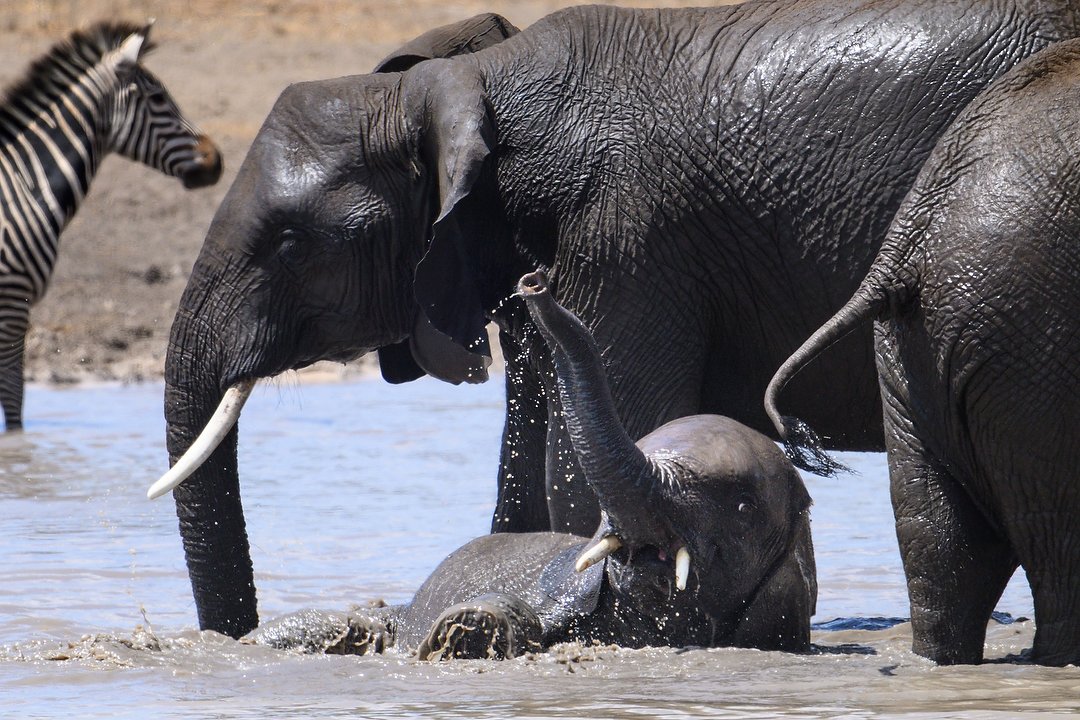
Elephants frolic in a watering hole shared with zebras in Tarangire N.P. Nikon Z 8, Aperture Priority, Natural auto white balance, ISO 1000, 1/1600 at f/9 in Matrix metering, -0.3 EV, Nikkor Z 400mm f/4.5 VR S Z lens with 2x teleconverter for 800mm.
Day Five
While this is primarily a wildlife photography trip, we’d be missing out if we didn’t learn about some of the tribes who live in Tanzania. The smallest, and most unique, are the Hadzabe people. One of the last remaining hunter-gatherer societies on earth, they number only a few hundred. Leaving our lodge at sunrise, we pick up a local guide from a nearby village and drive to where they’re camped. He translates as they explain how they live, after which we follow them on a hunt. Using bow and arrow, they shoot a bird and a squirrel. In about two minutes they’ve got a fire going (no matches or lighter, just friction with a couple of pieces of wood), cook the animals and offer us a taste.
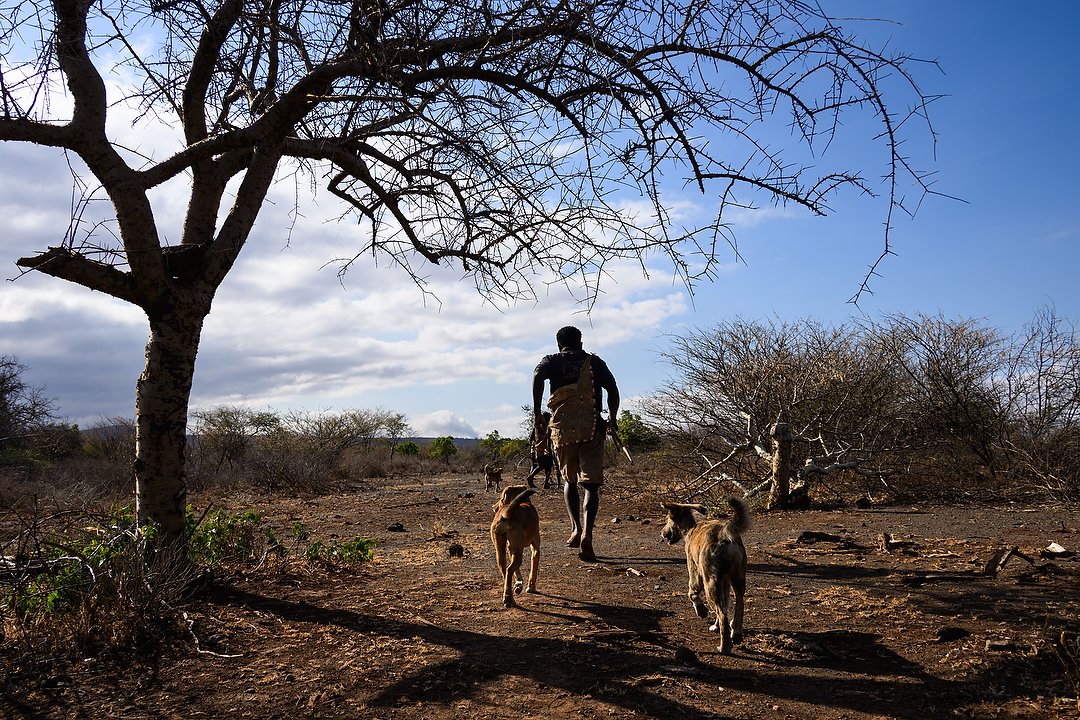
Following a group of Hadzabe bushmen, and their dogs, on a hunt near their camp. Nikon Z 8, Aperture Priority, Natural auto white balance, ISO 100, 1/400 at f/7.1 in Matrix metering, -0.3 EV, Nikkor Z 24-200mm f/4-6.3 VR lens at 29mm.
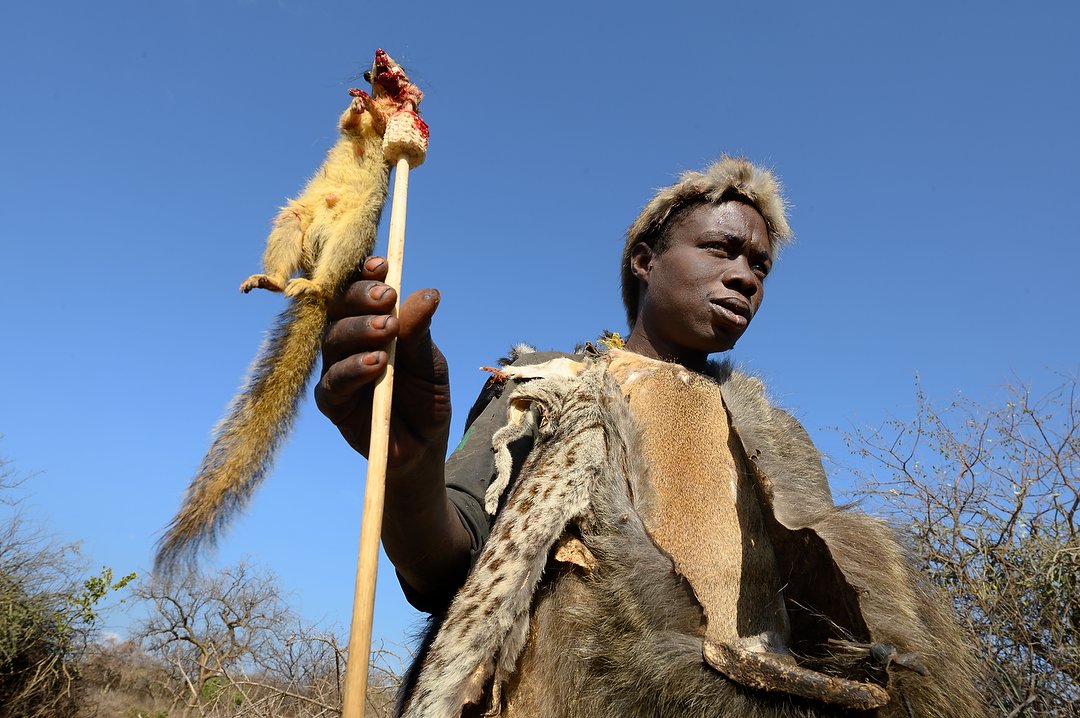
One of the bushmen shows us a squirrel he just shot from a tree with an arrow. They put a piece of corncob near the tip, so that if the arrow hits something hard only the tip breaks, so they can sharpen the remainder and use it again. In just a few minutes, they’ll have made a fire, cooked it and shared pieces with us. Nikon Z 6 II, Aperture Priority, Natural auto white balance, ISO 100, 1/100 at f/13 in Matrix metering, -1.3 EV, Nikkor 20mm f/1.8G lens.
After that we visit another tribe, the Datoga. While their society was originally based on livestock (like the Maasai), they’ve gradually turned to metalwork. Using a homemade bellows and coal, they melt copper to hammer out arrowheads, spear points and jewelry. Returning to our lodge late in the afternoon, many of us take naps before dinner (damn jetlag!).
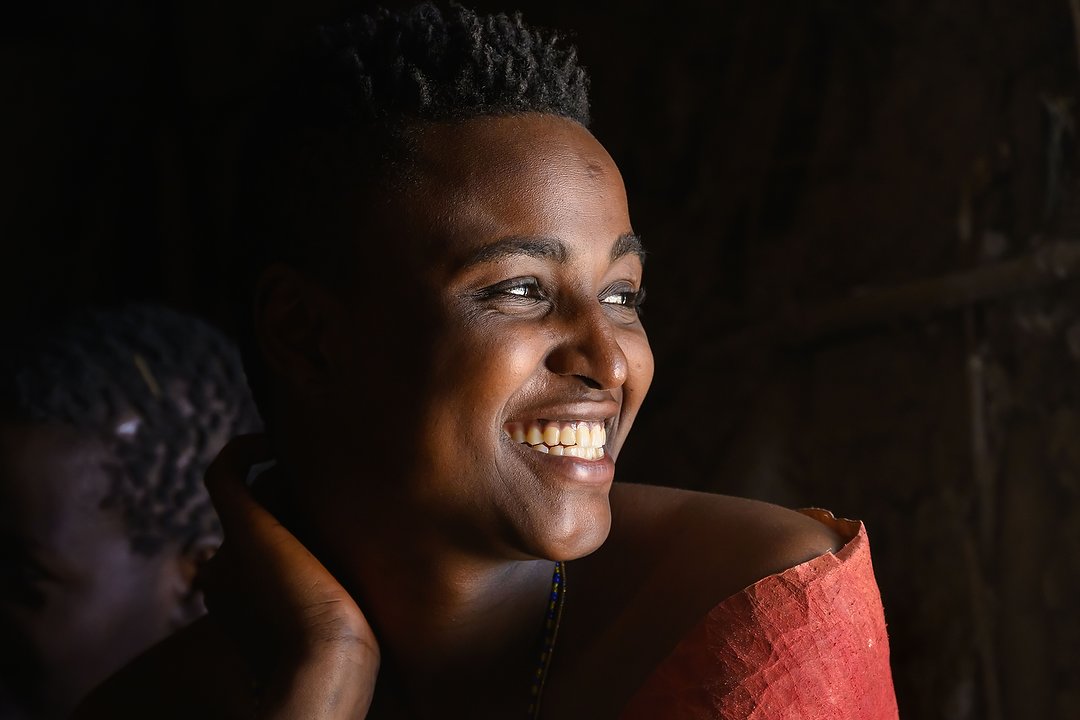
One of the Datoga women inside a home where they demonstrated how they ground grind with a stone for cooking. Nikon Z 8, Aperture Priority, Natural auto white balance, ISO 3200, 1/80 at f/6.3 in Matrix metering, -1.3 EV, Nikkor Z 24-200mm f/4-6.3 VR lens at 125mm.
Day Six
Today we’ll finally enter Serengeti National Park. To get there, though, we leave paved roads behind and take a dirt track up and around Ngorongoro Crater. Dropping down the far side, the roads turn to gravel and the land becomes arid and dusty. This is the home of the Maasai, whose lives center around their herds of cattle, sheep and goats. They also bring in hard currency by welcoming tourists like ourselves (for $20/person). After welcoming songs and dances, we’re given a tour of their boma (village) and invited to see how they live in small huts made of sticks, mud and cow dung. We also visit the small shack that serves as a school for young children. When they’re older they’ll go away to a boarding school, and return to the tribe during breaks from school.
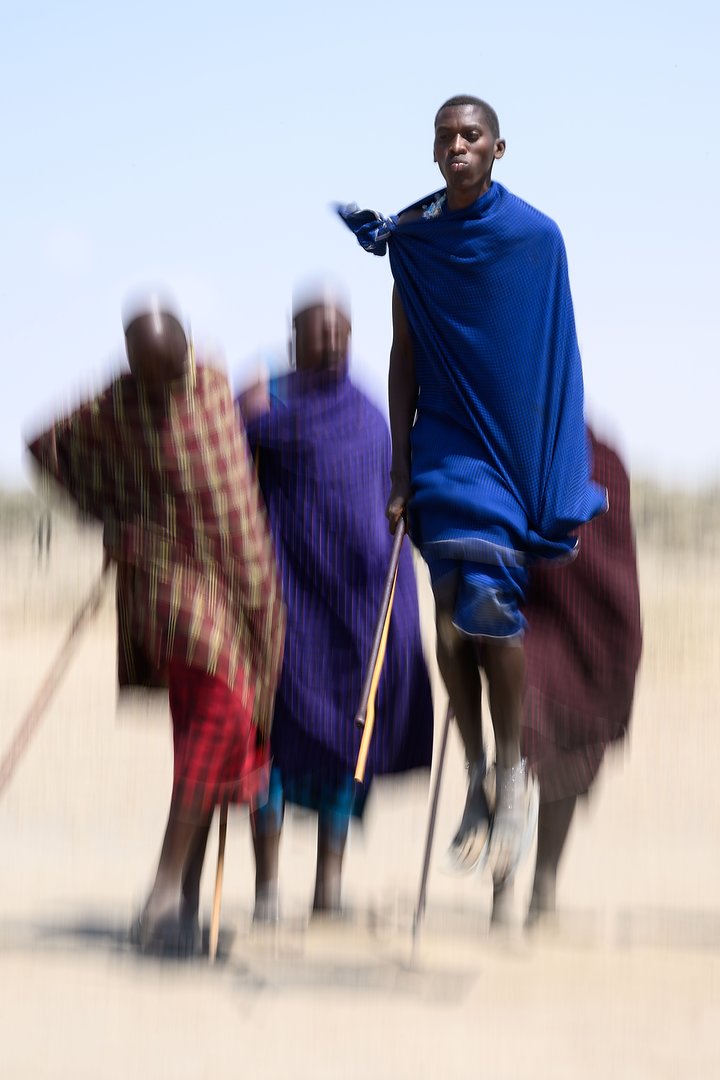
Maasai men do their classic jumping while the group sings a welcome song. Nikon Z 8, Aperture Priority, Sunny white balance, ISO 64, 1/15 at f/25 in Matrix metering, -0.3 EV, Nikkor Z 24-200mm f/4-6.3 VR lens at 115mm.
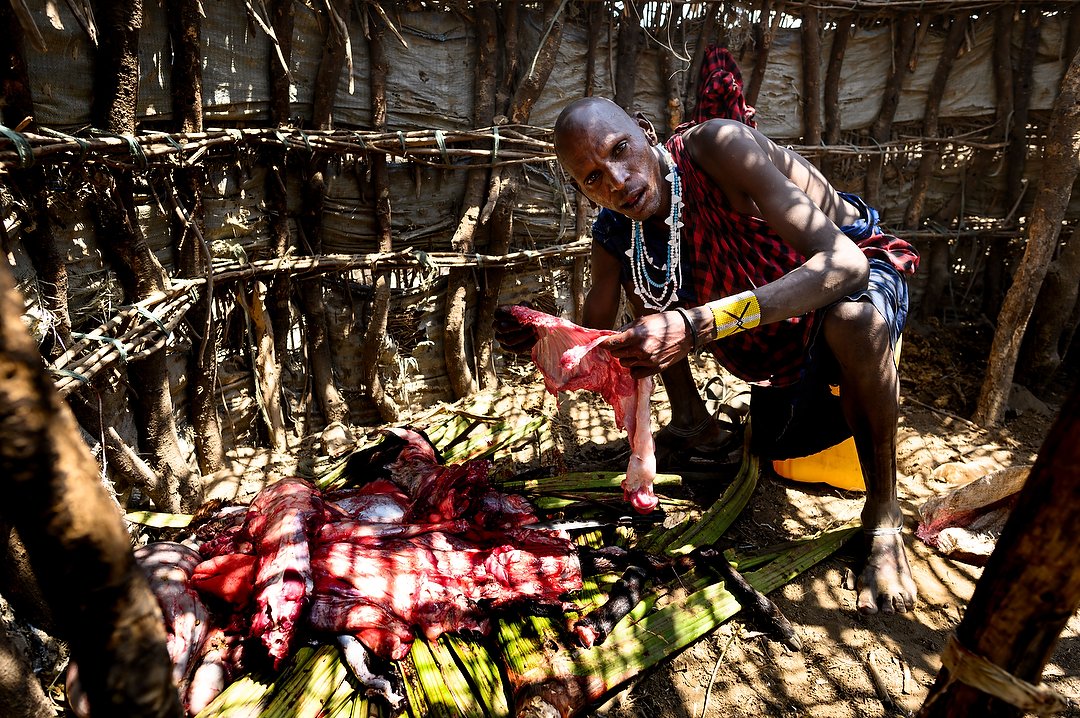
Nearby, another Maasai man was butchering a goat. Nikon Z 6 II, Aperture Priority, Sunny white balance, ISO 100, 1/125 at f/4 in Matrix metering, 0.0 EV, Nikkor 20mm f/1.8G lens.
After leaving the Maasai, more driving on gravel roads finally brings us to the Serengeti. We stop at the entrance station for a picnic with box lunches while the guides deal with paperwork. Finally, after climbing into the trucks once more, we head out on “game drive,” which is just what it sounds like – driving around, looking for wildlife (game).
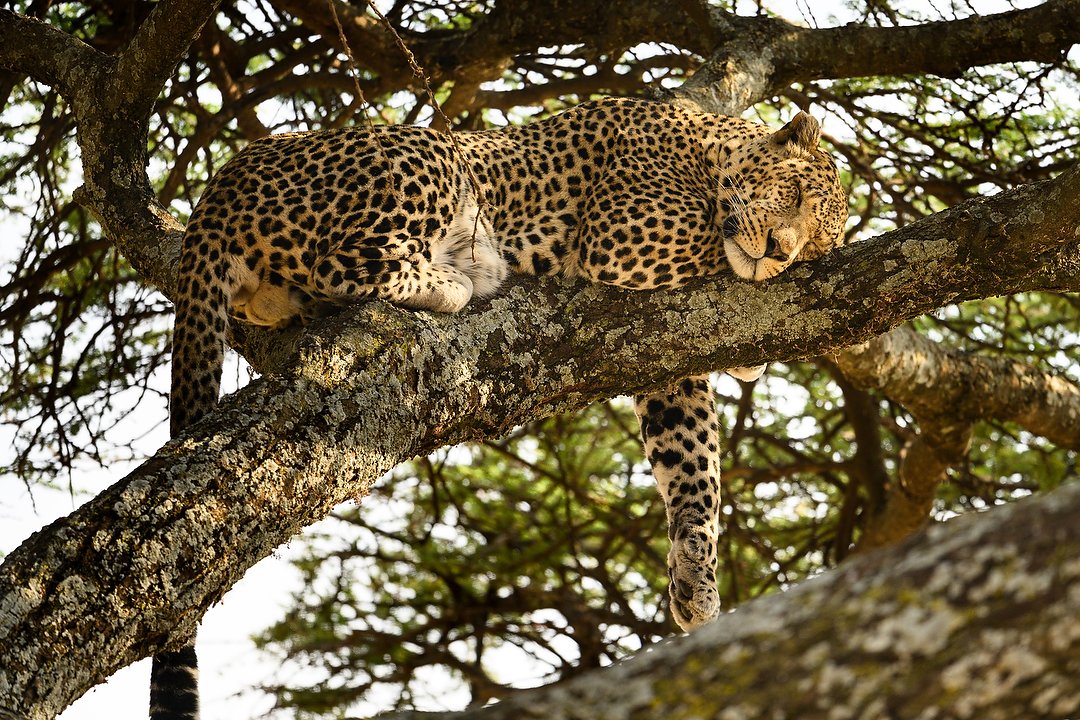
Not bad for our first afternoon game drive in Serengeti, finding a leopard napping in a tree. Nikon Z 8, Aperture Priority, Sunny white balance, ISO 450, 1/500 at f/4.5 in Matrix metering, +0.7 EV, Nikkor Z 400mm f/4.5 VR S lens.
Our home this night, and for the following five nights, is what’s referred to as a “mobile camp.” Not permanent, like the large lodges in the Serengeti, these camps can be taken down and moved. Some are in place as little as six weeks, others for up to five years. However, it’s not “camping” as we tend to think about it. For this first one there’s a large lounge tent (with bar) and another large tent for dining. The tents we sleep in have wood floors, large beds, bathrooms (with showers), lights and power. Yes, the walls are canvas, but otherwise it’s nicer than many hotels I’ve stayed in. I prefer these over the lodges because they’re smaller and more intimate, are quieter and put you closer to the wildlife. Plus, you can lie in bed at night and listen to the lions, hyenas and wildebeest, which is pretty darn cool. Oh, and yes, there is internet. It may be slow, but if you want, you can be connected to the outside world.

My tent at our first mobile camp. Some of these camps are in place longer than others, so a bit fancier and more developed than the short-term ones. iPhone photo.
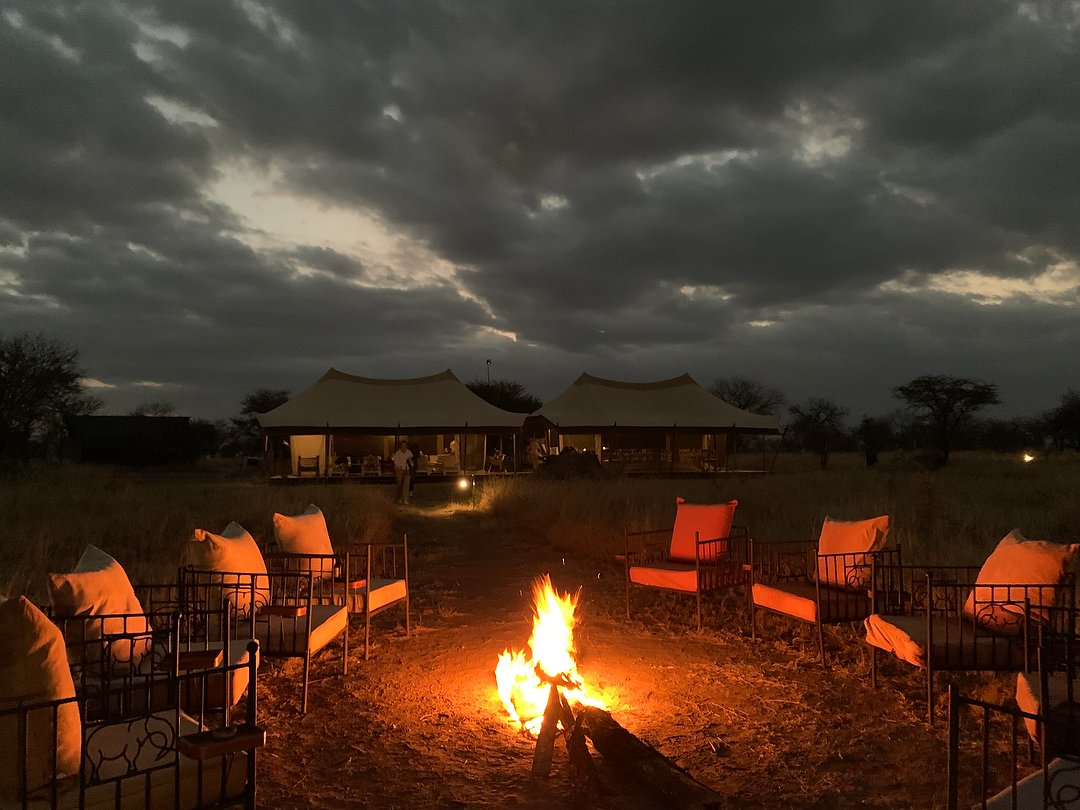
The fire pit where some of us would retire with drinks after sunset, and in back, the lounge/bar tent, left, and dining tent, right. iPhone photo.
Day Seven
A few of the group are picked up before sunrise for a morning balloon ride (an extra $600 each), the rest of us get up at sunrise, have breakfast, then leave for another game drive. This is the routine we’ll follow the rest of the time on safari. Leave early on game drives, eat box lunches while out, return to camp at sunset. I learned on my first safari in 2005 that time equals opportunity. If you use up time driving back to your camp (or lodge) for lunch, you’ll have less time seeing and photographing wildlife.
This afternoon, though, we do take a break from game drive to exit the national park and work our way north. I made this change to the itinerary in 2021, sacrificing a few hours of game drive to re-locate to the Mara River, near the Kenyan border. We’ll spend three nights there, at a more basic mobile camp, in hopes of photographing the great migration crossing the river.
Over a million wildebeest (joined by a lot of zebra) make this clockwise journey each year, following the rains and resulting fresh grass. The Mara River is the largest obstacle in their path, so huge herds form on the south side, building up the nerve to cross. One fear is crocodiles, of which there are many, hoping for a meal. And, when the wildebeest do decide to cross, it turns into a mad rush, which results in some of them breaking a leg and drowning. Needless to say, that crossing makes for good pictures. But it also requires patience. There are about a dozen regular crossing points, and you look for wildebeest gathering at one. Finding that, you park well away from them and wait, hoping they decide to cross (sometimes they turn back). If they do decide to cross, it becomes a stampede, but not just the animals. All the trucks that have been sitting back, waiting, also race to the river so the passengers can see the crossing.
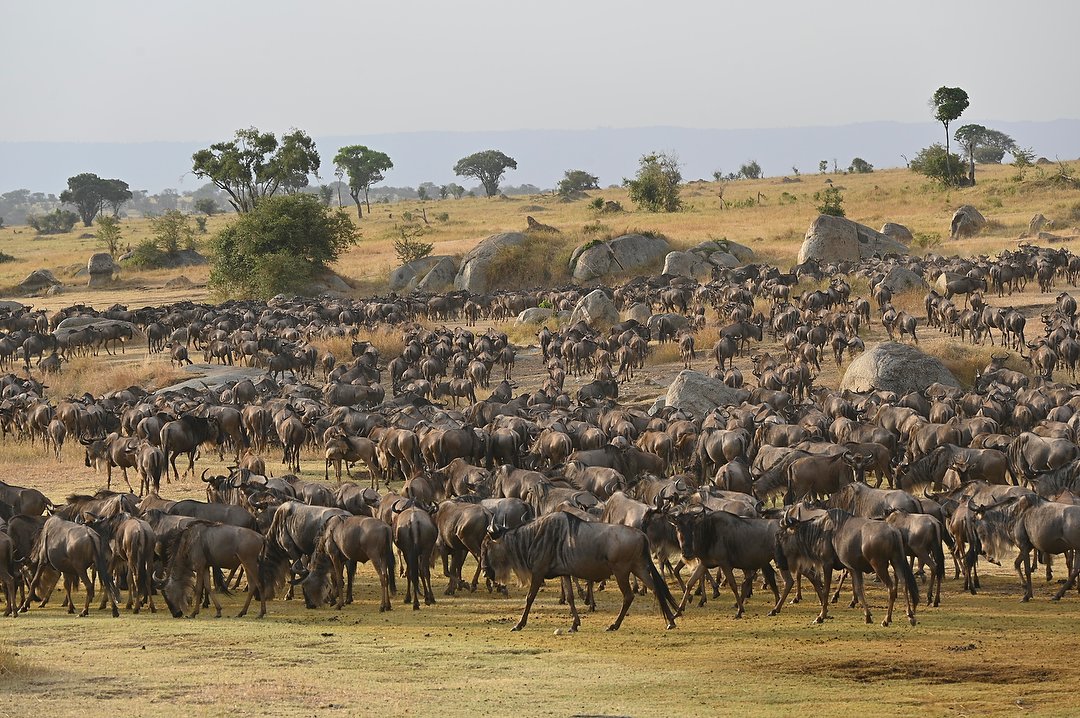
As we neared the Mara River late that first afternoon, we found larger and larger groups of wildebeest on the move towards it. Nikon Z 6 II, Aperture Priority, Sunny white balance, ISO 320, 1/400 at f/8 in Matrix metering, -0.3 EV, Nikkor Z 24-200mm f/4-6.3 VR lens at 135mm.
Day Eight
Since our camp is on the south side, that’s where we start this morning. We find a large group gathering, and park well back from the wildebeest to avoid spooking them. Just over an hour later, they start to cross and the rush begins. Our trucks drive up to the bank, we stand up and photograph the action in the river below. Once that group finished crossing, we moved east and cross the river ourselves (on a bridge), to try to photograph a crossing from the front. Same as earlier, we find a group gathering on the far side, park and wait. When they start crossing, we move closer to the river and start shooting. Having now seen two crossings, we shift gears and go back into game drive mode. There’s more to see than just the migration, so our guides drive us out onto the plains away from the river. On my many trips to the Serengeti, I’ve only seen a few chases, and rarely a kill. This afternoon, though, we see lions take down a wildebeest not once, but twice. The lions don’t migrate, so when the migration comes through the area, they eat well.
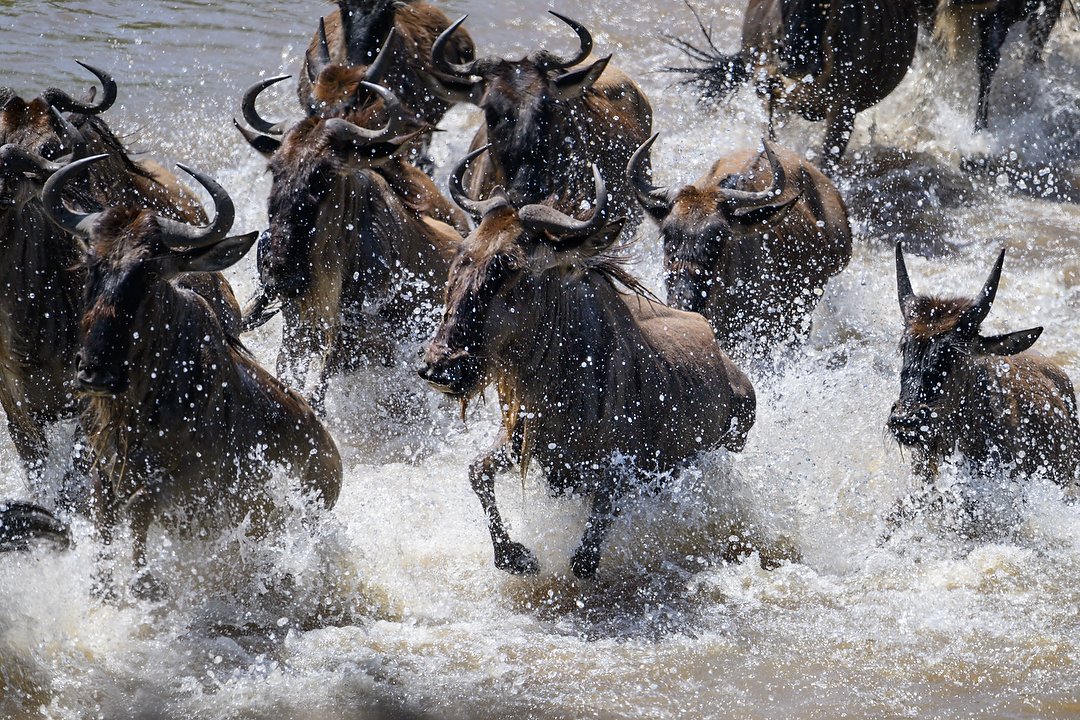
This is the most exciting part of seeing the great migration, as thousands of wildebeest stampede across the Mara River. Nikon Z 8, Aperture Priority, Sunny white balance, ISO 400, 1/1600 at f/6.3 in Matrix metering, 0.0 EV, Nikkor Z 400mm f/4.5 VR S Z lens with 1.4X teleconverter for 560mm.
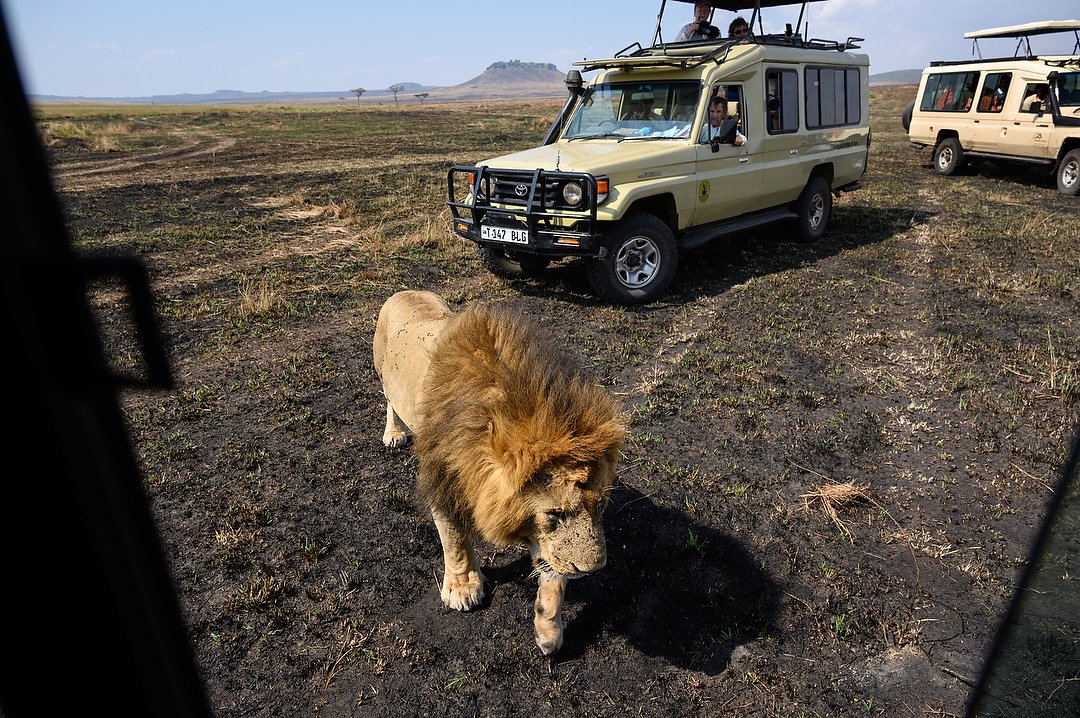
Our three trucks were parked watching some lions when they make decided to move. Grabbing my second camera that had a wide-angle lens, I moved back away from the truck’s window as it walked by. The wildlife doesn’t pay much attention to the trucks, but I’d still rather not tempt a predator! Nikon Z 6 II, Aperture Priority, Sunny white balance, ISO 250, 1/800 at f/6.3 in Matrix metering, -0.7 EV, Nikkor Z 24-200mm f/4-6.3 VR lens at 24mm.

After chasing and knocking down this wildebeest, the lioness grabbed it by the throat to suffocate it. That’s how they normally kill their prey. Nikon Z 8, Aperture Priority, Sunny white balance, ISO 280, 1/800 at f/4.5 in Matrix metering, 0.0 EV, Nikkor Z 400mm f/4.5 VR S lens.
Day Nine
Our last full day on the Mara River is another busy one, photographing one more crossing, then once again heading out into the surrounding plains. This time we find a pair of cheetahs. Following the two from a distance, we see them take down a wildebeest. Once it’s dead, we move closer and photograph them feeding. Later, we’d make some nice baby elephant photos. But cheetahs! And a kill!
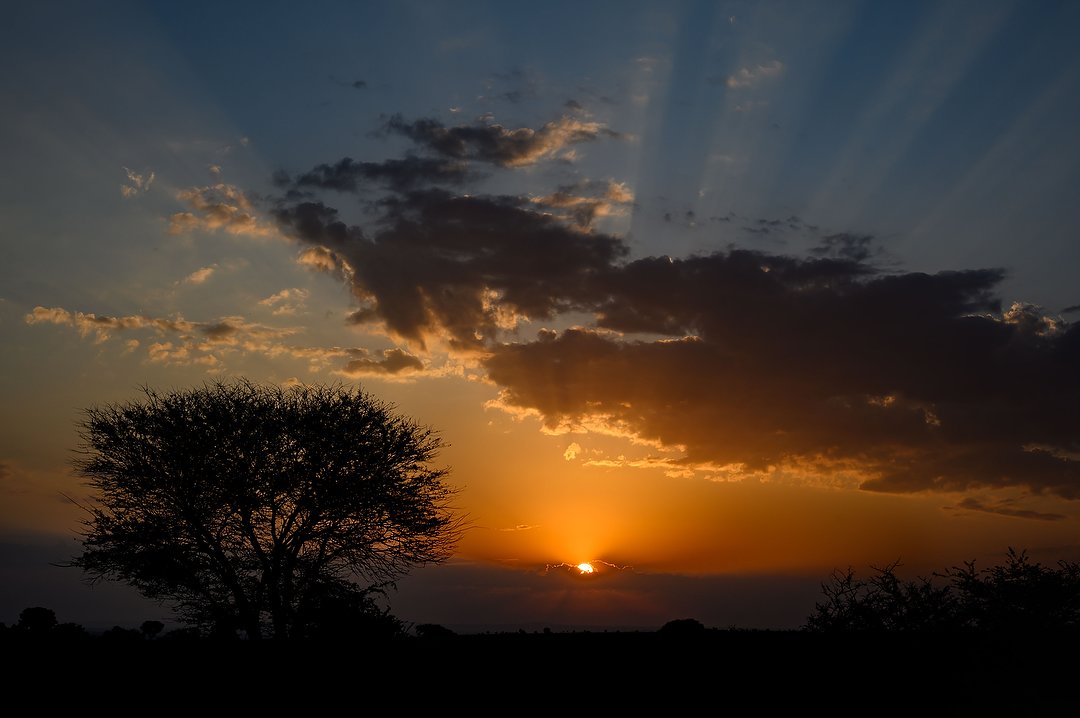
A beautiful sunrise greeted us on our last day at the Mara River camp. Nikon Z 6 II, Aperture Priority, Sunny white balance, ISO 100, 1/640 at f/9 in Matrix metering, -2.0 EV, Nikkor Z 24-200mm f/4-6.3 VR lens at 50mm.
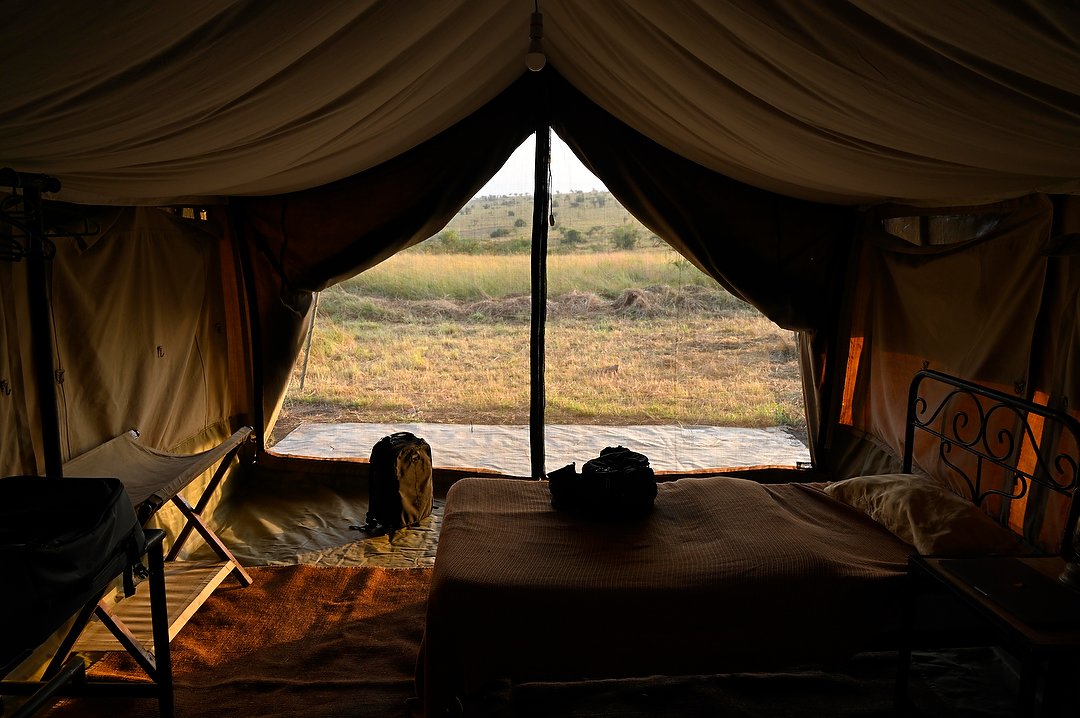
The camp at Mara River is only in place during the time of the crossings, so is more basic. This is the main room of my tent, with the bathroom behind me. To shower, camp staff fills a 20-liter water bag hung above the back of the tent with hot water, which means quick showers! Nikon Z 6 II, Aperture Priority, Sunny white balance, ISO 400, 1/20 at f/8 in Matrix metering, -0.7 EV, Nikkor Z 24-200mm f/4-6.3 VR lens at 24mm.
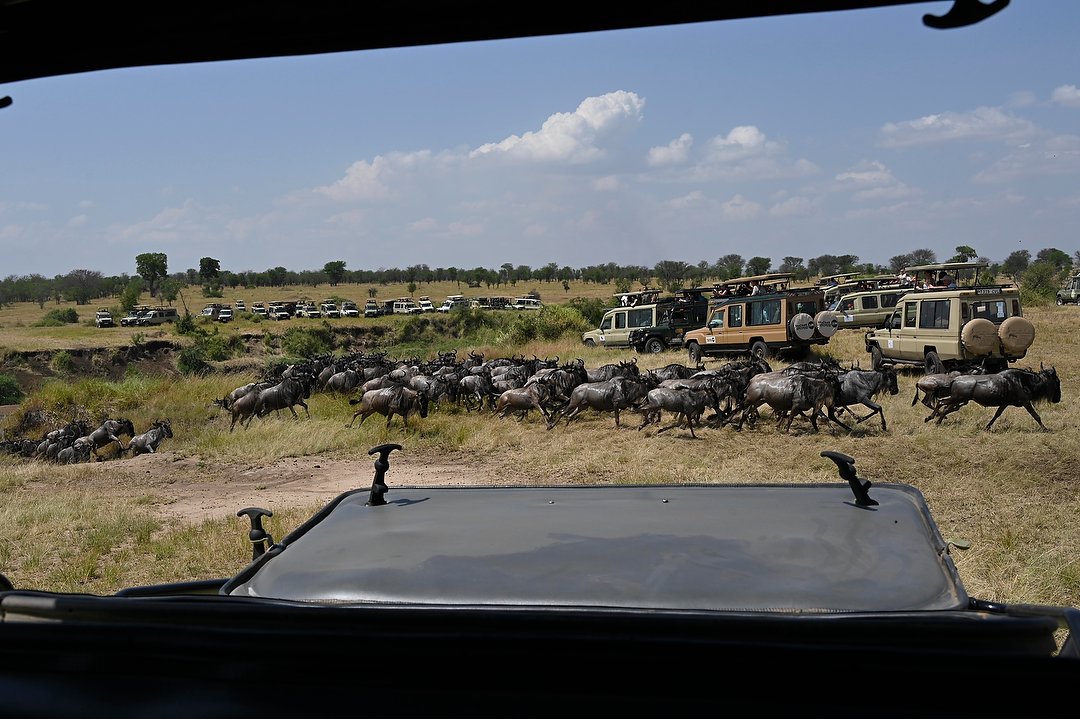
Here you can see how trucks gather on both sides of the river to wait for the wildebeests to cross. Nikon Z 6 II, Aperture Priority, Sunny white balance, ISO 250, 1/800 at f/10 in Matrix metering, -0.7 EV, Nikkor Z 24-200mm f/4-6.3 VR lens at 35mm.
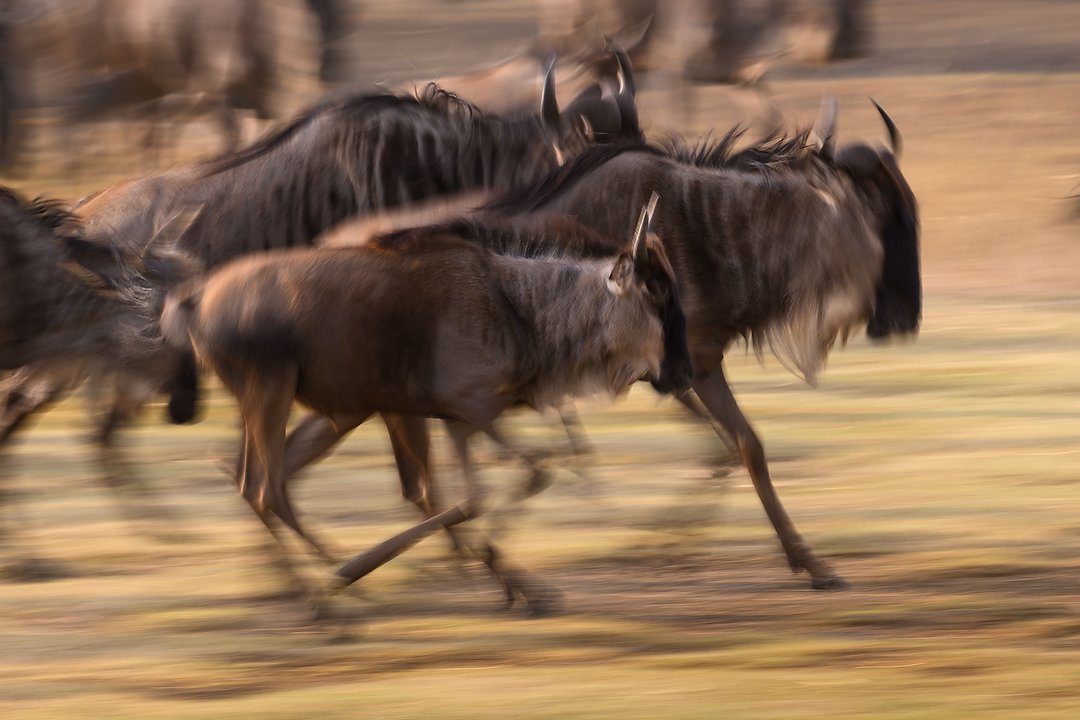
Since we see so many wildebeest over a couple of days, there’s time to experiment with our photography. This is called “panning,” where you use a slow shutter speed while following the subject, which creates more blur in the background than with the subject. Nikon Z 8, Aperture Priority, Sunny white balance, ISO 64, 1/25 at f/13 in Matrix metering, 0.0 EV, Nikkor Z 400mm f/4.5 VR S lens.
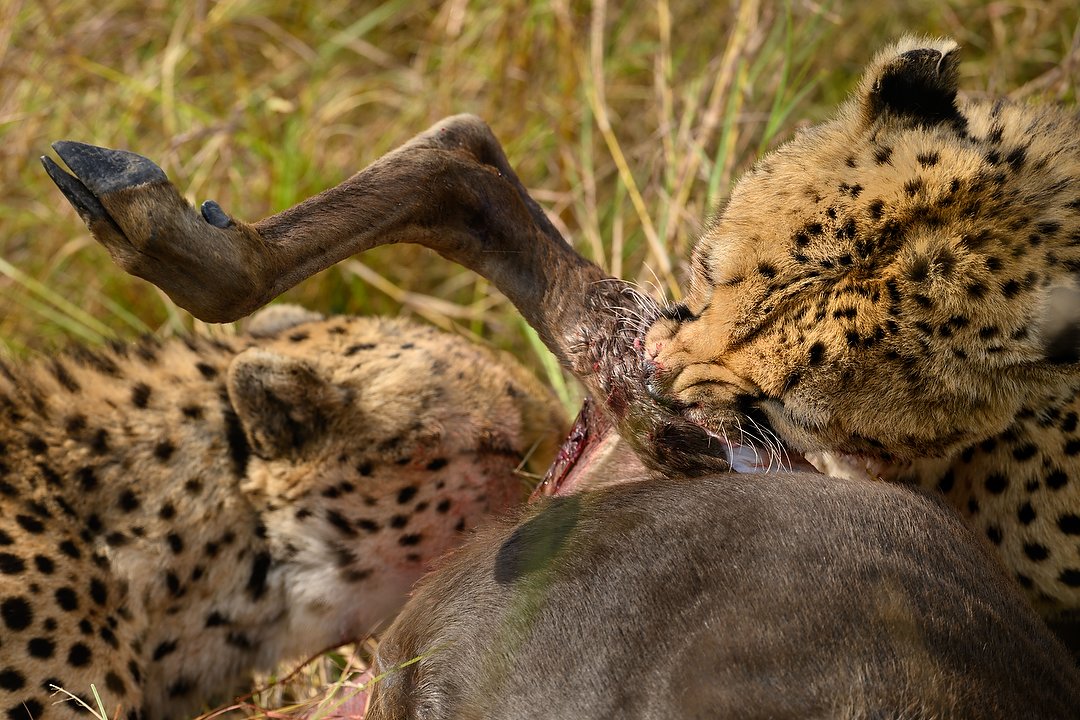
Here’s that pair of cheetahs we watched hunt a wildebeest, enjoying the fruit (meat?) of their labors. They need to eat fast, because other predators, like hyenas and lions, often chase them away from their kills. Nikon Z 8, Aperture Priority, Sunny white balance, ISO 220, 1/1000 at f/5 in Matrix metering, 0.0 EV, Nikkor Z 400mm f/4.5 VR S lens.
Day Ten
It’s time to leave the Mara River, so we make the long, bumpy ride south, returning to the main part of the Serengeti. Once there, our first stop is the “Hippo Pool.” There are many places you’ll see hippos, but this is one of the best, often with over a hundred of them at rest in the water. Hippos’ skin is sensitive to sunlight, so they prefer to spend daytime in the water and come out at night to feed. The rest of our day is spent on game drive, returning to the first mobile camp we stayed at, where we’ll spend two more nights.
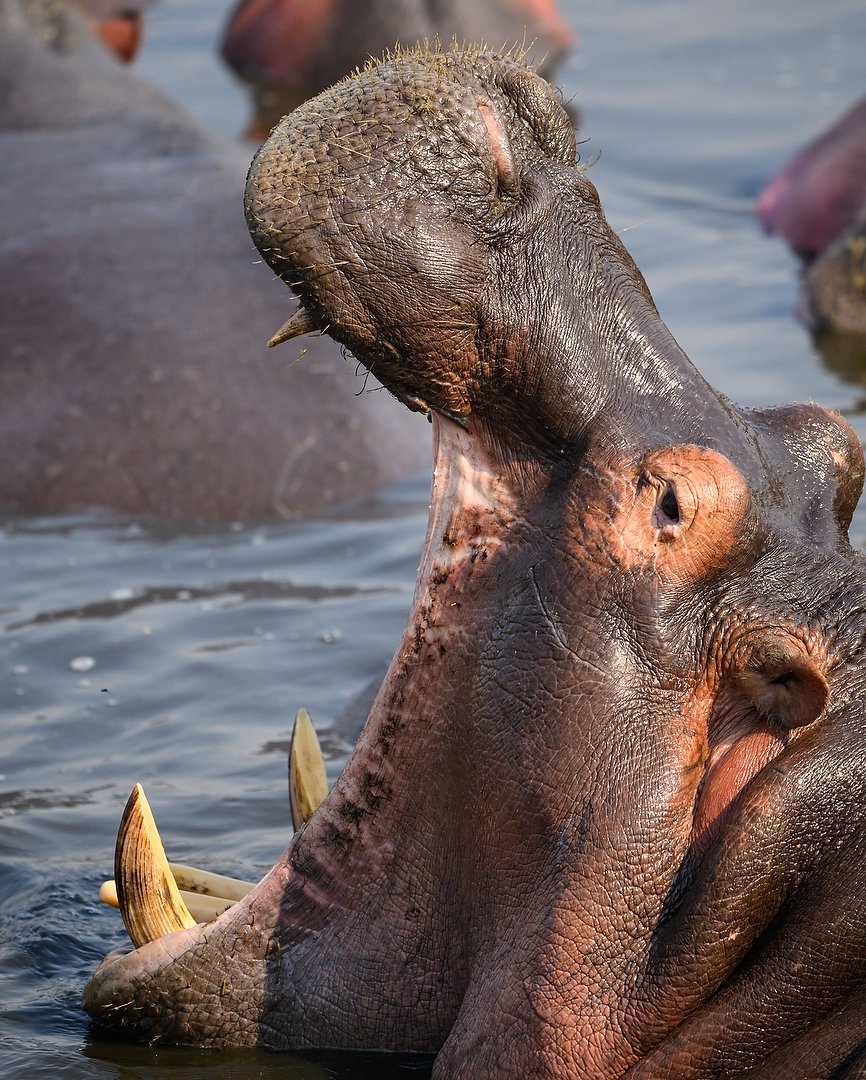
It just wouldn’t be a safari without a hippo showing off its massive mouth and teeth. Nikon Z 8, Aperture Priority, Sunny white balance, ISO 500, 1/1600 at f/4.5 in Matrix metering, 0.0 EV, Nikkor Z 400mm f/4.5 VR S lens.
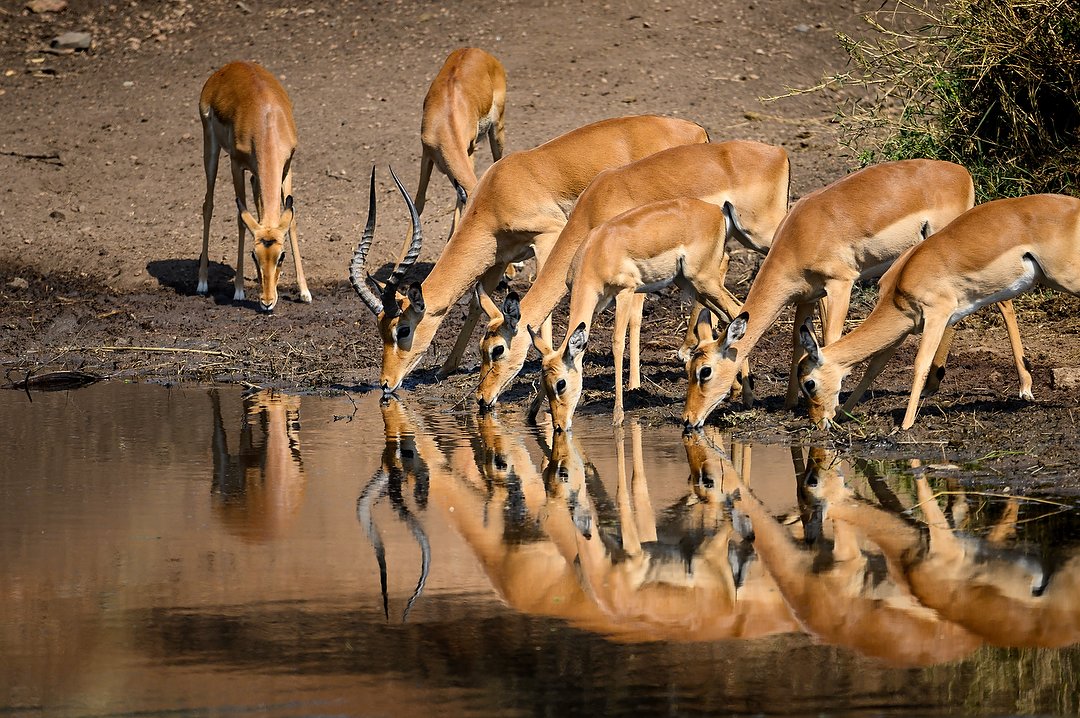
A male impala joins his “harem” for a drink. Like elk, larger, stronger male impalas gather a group of females to increase the odds of passing along their genes. Our guides don’t simply drive us around, they also explain the behavior of the different wildlife we’re seeing. Nikon Z 8, Aperture Priority, Sunny white balance, ISO 220, 1/1600 at f/4.5 in Matrix metering, 0.0 EV, Nikkor Z 400mm f/4.5 VR S lens.

While most of our time is spent looking for the larger African wildlife, we also see lots of birds, and photograph them as well when they’re close. This is a lilac-breasted roller, one of the most colorful. Nikon Z 8, Manual exposure, Sunny white balance, ISO 1100, 1/2500 at f/6.3 in Matrix metering, 0.0 EV, Nikkor Z 400mm f/4.5 VR S Z lens with 1.4X teleconverter for 560mm.
Day Eleven
Our last full day in the Serengeti, it’s a good one. First we find a cheetah, and watch as it hunts and walks right up to our trucks. Then there’s a pride of lions asleep under a tree. At this point in the trip – since we’ve already seen and photographed so much – I decide we’re just going to sit and wait, to see if the lions wake up. This is part of what I bring to the trip, the experience of having been there many times before, with knowledge of what to expect. I know that lions, leopards and cheetahs rarely sleep in one spot all day. They tend to take naps, occasionally getting up to stretch and move. This group eventually does, and then are joined by a couple of others who were nearby and do a little socializing. Once more, time = opportunity. We had the time to wait, and it paid off. Leaving there we found a leopard napping high up on a rock. It wasn’t much of a photo, but what if it got up and moved? So again, we sat and waited, and ate our box lunches. And guess what? It got up, moved, laid down, got up again, then came down off the rock. There was a tree not far away, and since leopards like to climb into trees, I asked our guide to move us close to that tree. Sure enough, it walked through the tall grass towards us, climbed the tree and laid down for a nap. Nice! Then later that afternoon, as we slowly worked our way back to camp, we came across a group of elephants with a baby. I love watching elephants. They’re very social, with lots of touching, and very protective of the little ones.
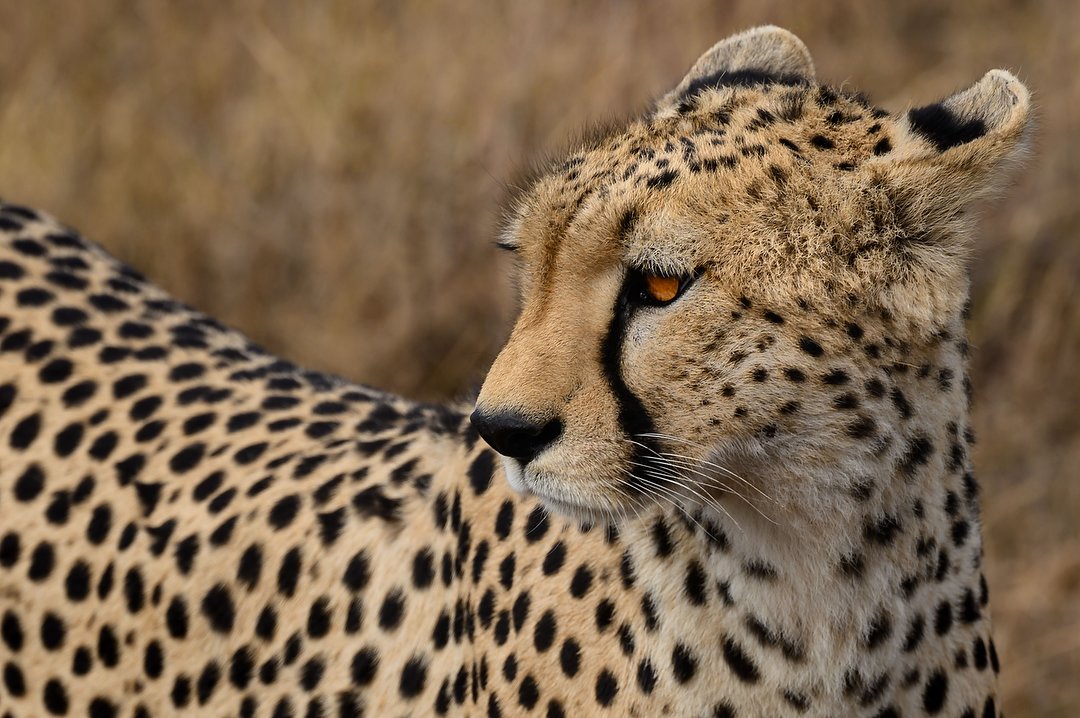
This is full-frame –with my shorter lens – as the cheetah walked right towards us, stopped near our truck, then passed behind it on the way to stalk a gazelle. Nikon Z 6 II, Aperture Priority, Sunny white balance, ISO 200, 1/400 at f/8 in Matrix metering, -0.3 EV, Nikkor Z 24-200mm f/4-6.3 VR lens at 200mm.
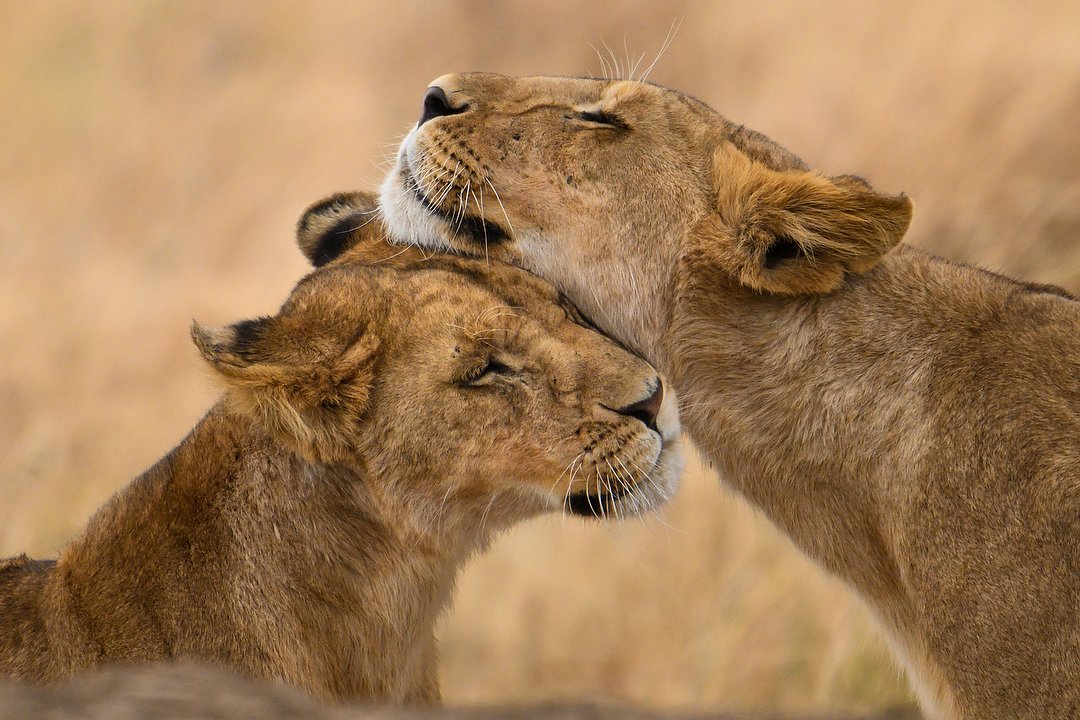
Patience paid off, waiting until this pride of lions woke up. They rewarded us with a display of greeting aaffection. Nikon Z 8, Aperture Priority, Sunny white balance, ISO 1100, 1/1250 at f/9 in Matrix metering, 0.0 EV, Nikkor Z 400mm f/4.5 VR S Z lens with 2X teleconverter for 800mm.
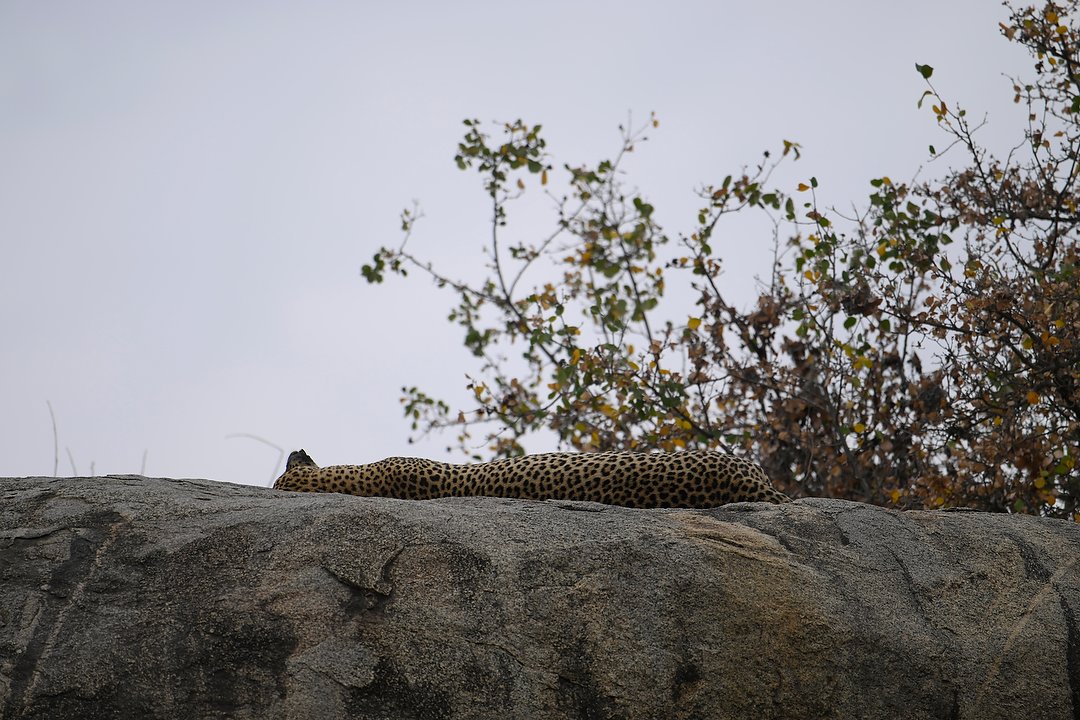
Here’s what the leopard was doing when we found it. Not much of a picture. Again, though, we had time and were in no rush, so decided to wait and see what happened. Nikon Z 8, Aperture Priority, Sunny white balance, ISO 250, 1/1250 at f/6.3 in Matrix metering, +0.3 EV, Nikkor Z 400mm f/4.5 VR S Z lens with 1.4X teleconverter for 560mm.
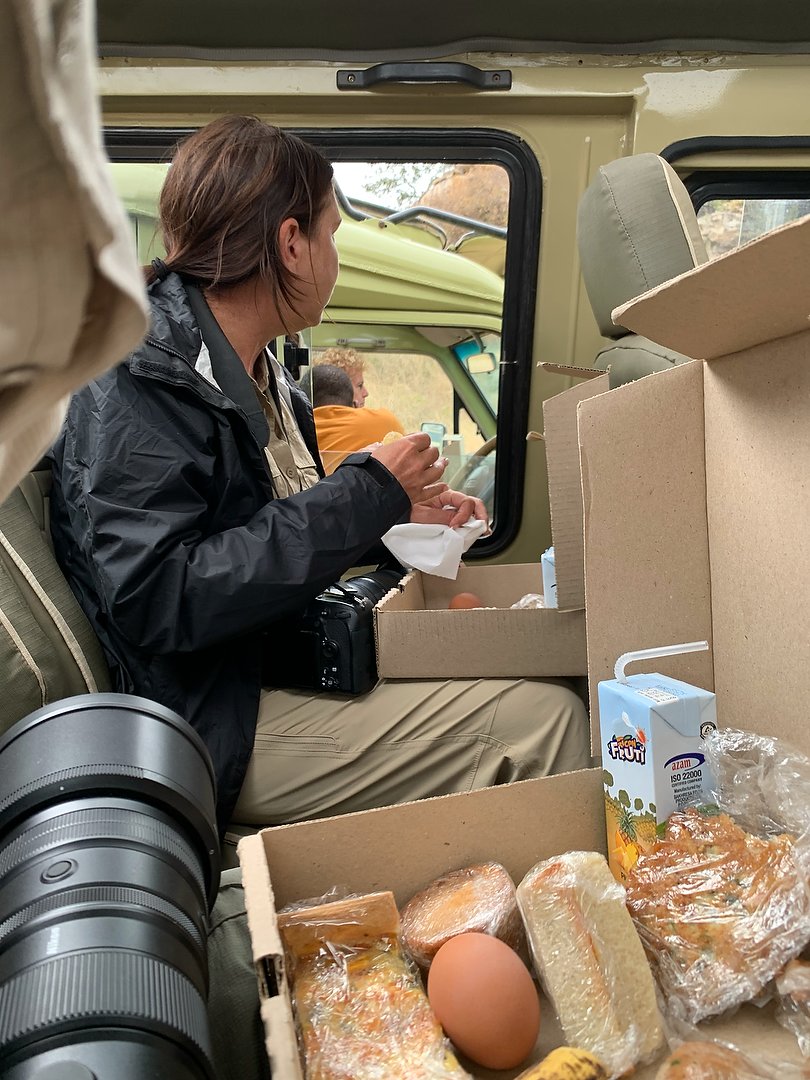
Watching and waiting for it to wake up, we ate lunch in the trucks. Taking box lunches with us every day meant we could eat whenever, and wherever, we wanted. iPhone photo.
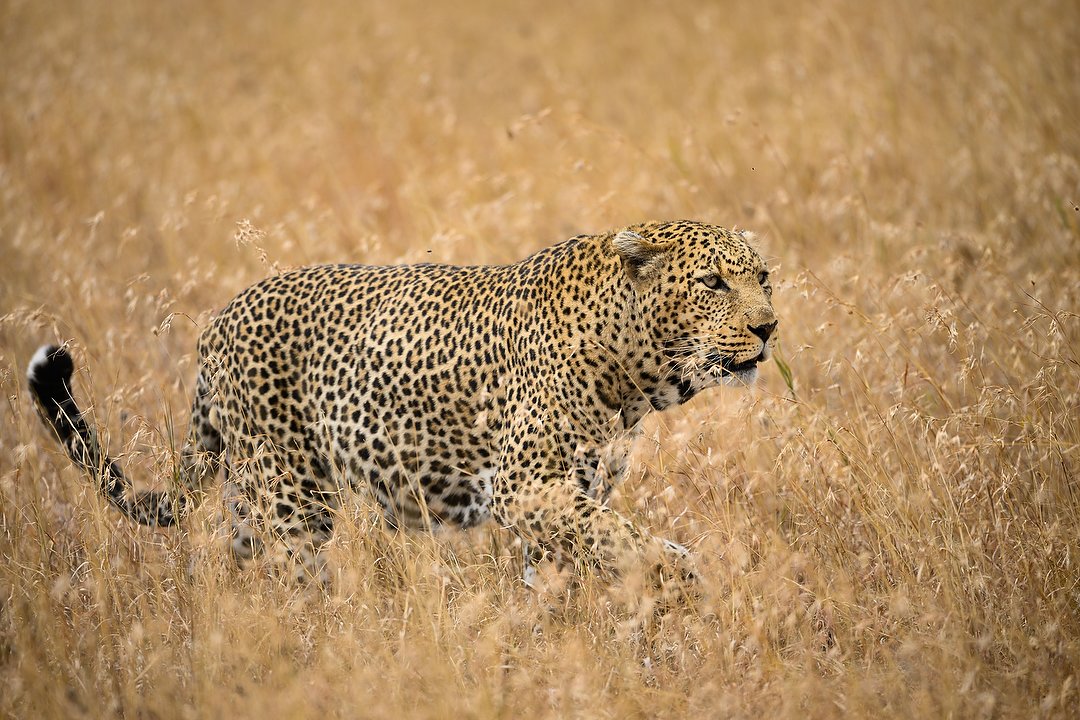
Waiting for over an hour paid off, as the leopard woke up, came down off the rock and headed for a nearby tree. Nikon Z 8, Aperture Priority, Sunny white balance, ISO 180, 1/1250 at f/4.5 in Matrix metering, 0.0 EV, Nikkor Z 400mm f/4.5 VR S lens.
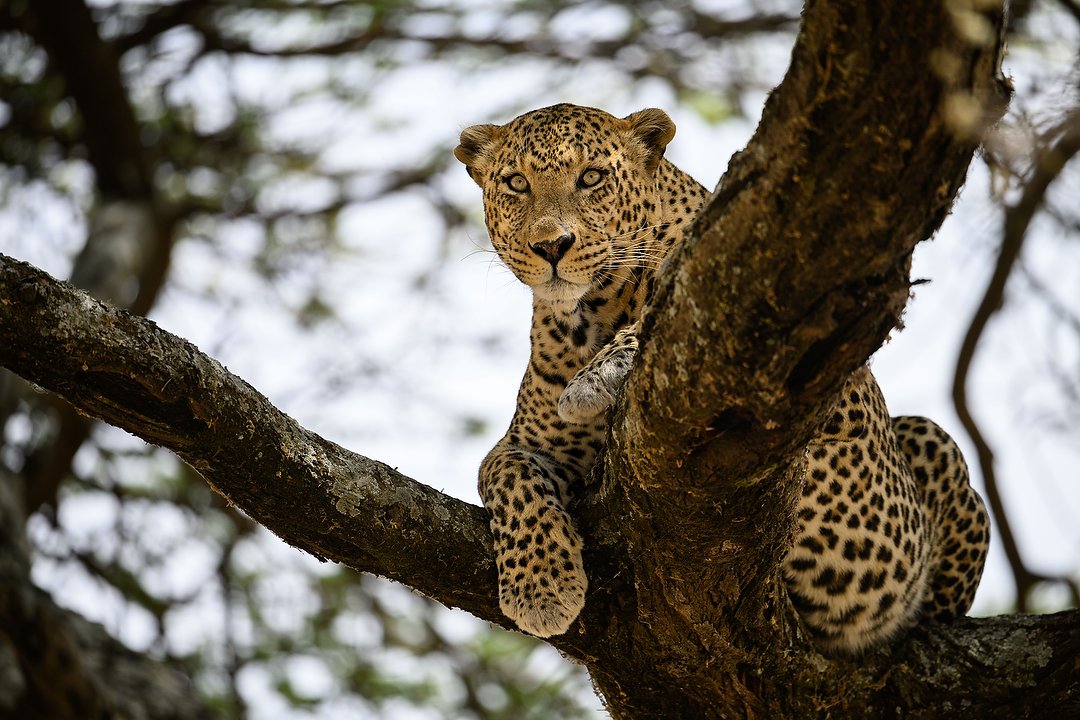
And at the end, we got the classic shot of a leopard. There were at least fifteen trucks around us when it was napping on top of the rock, but most of them had left by the time it came down and went to the tree. Nikon Z 8, Aperture Priority, Sunny white balance, ISO 450, 1/1250 at f/4.5 in Matrix metering, +0.7 EV, Nikkor Z 400mm f/4.5 VR S lens.
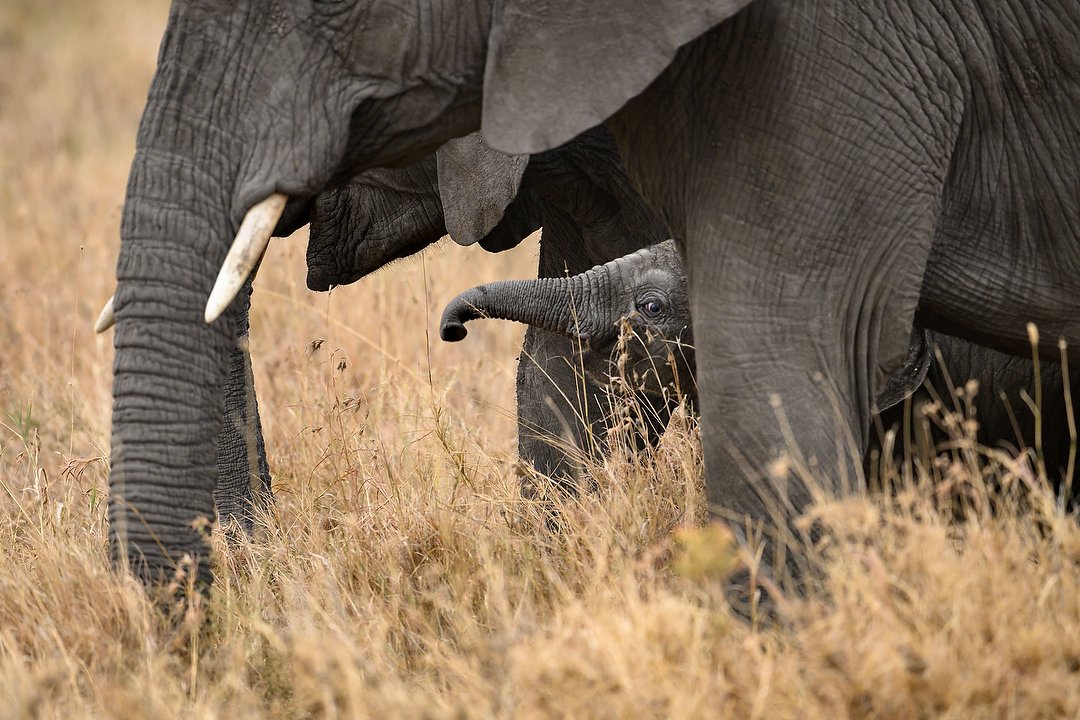
The icing on the cake at the end of the day was finding a group of elephants, with one small baby tucked in among them. Nikon Z 8, Aperture Priority, Sunny white balance, ISO 1250, 1/640 at f/4.5 in Matrix metering, +1.0 EV, Nikkor Z 400mm f/4.5 VR S lens.
Day Twelve
While we’ve finsihed with the Serengeti, we’re not done with our safari. Hitting the road early once more, we soon came across a serval cat walking along the edge of the road. About the same size as a house cat, they have very long legs, and I’d only ever seen one once before. That was a good sign of things to come, as we were on our way to Ngorongoro Crater. The explosion of that volcano eons ago is what created the Serengeti plain, and the resulting caldera is home to many of the region’s different animals. Having already seen so many other species of wildlife, our hope was to spot one of the black rhinos that live there. Hunted nearly to extinction, Ngorongoro is a safe haven for over thirty of them, as it’s extremely difficult for poachers to get at them there. We heard of a sighting soon after entering, but reaching the location, all we could see were some rocks in the distance. Later, though, as we neared our the lunch spot we saw a group of trucks parked to the side. There, in the distance, was a black rhino. Unfortunately, that distance, combined with the dust and heat waves, made it difficult to get much of a picture. But at least we saw one. After lunch, though, our guide suggested checking on it again. Good news – it had moved closer, the other issues were less troublesome and we not only could see it better, but get some decent pictures. While we photographed other animals that day, this rhino was the highlight, and meant we’d seen the “big five” during our time there. As a final touch, leaving Ngorongoro late that afternoon, we saw another serval cat before making the drive back to Karatu (and pavement!), and our lodge for the final night.
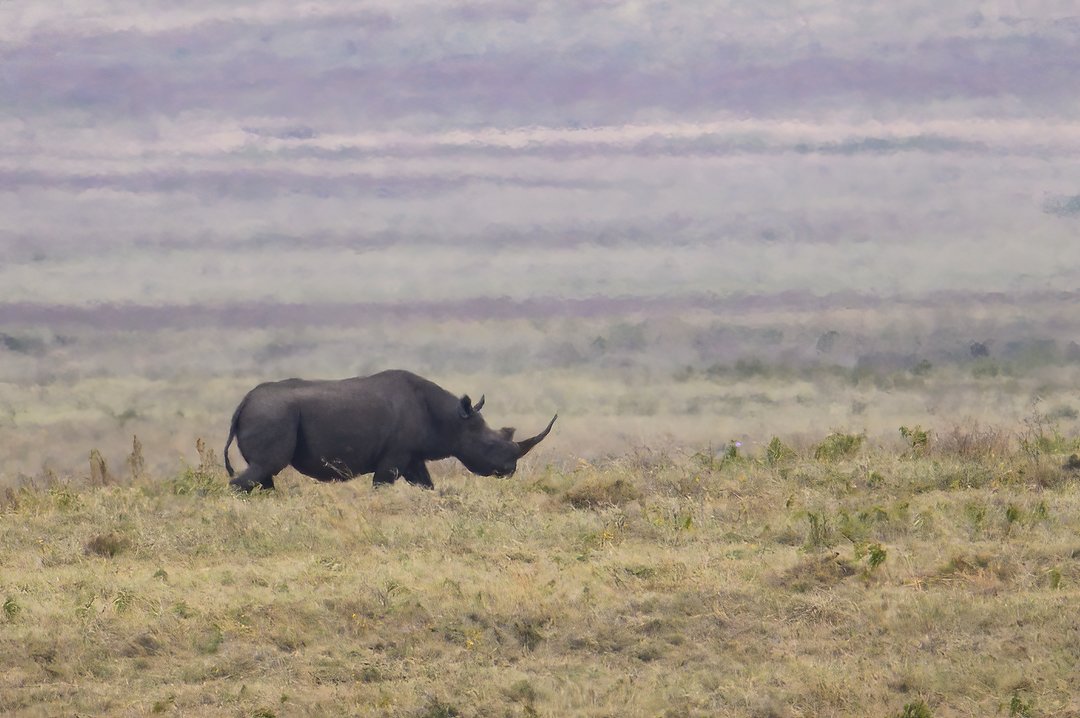
Try, try again… Finally we got a decent view of one of Ngorongoro’s black rhinos. And what a horn! Nikon Z 8, Aperture Priority, Sunny white balance, ISO 720, 1/1250 at f/9 in Matrix metering, 0.0 EV, Nikkor Z 400mm f/4.5 VR S Z lens with with 2X teleconverter for 800mm.
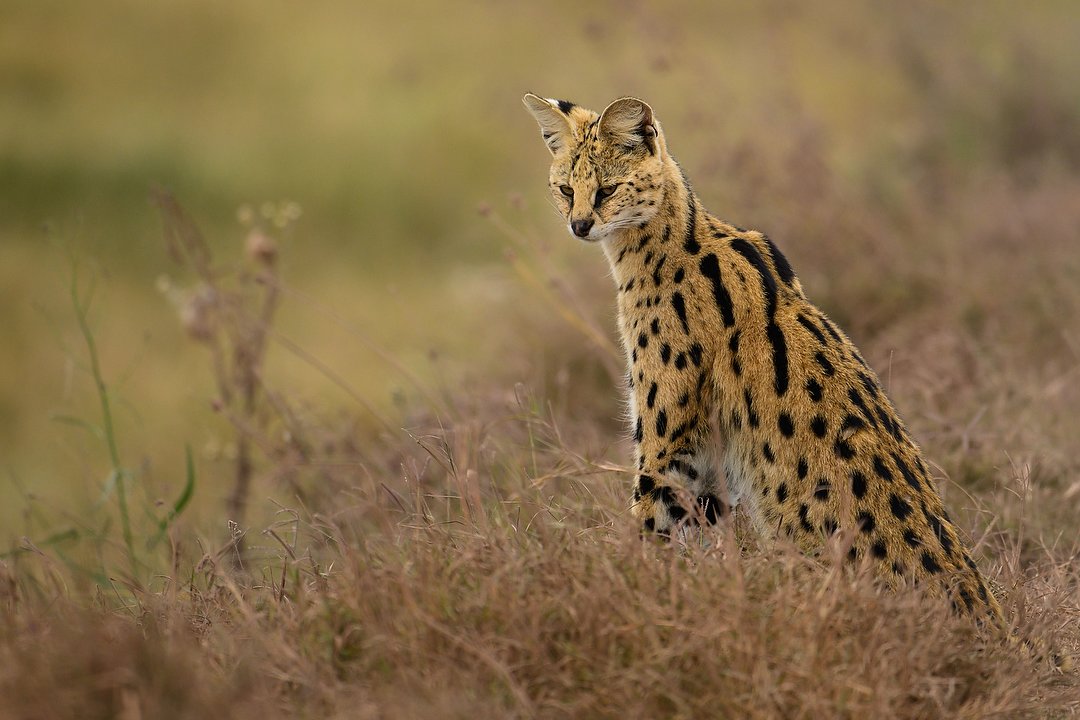
Serval cat, anyone? It was just sitting off the side of the track in Ngorongoro, hunting for small critters. Nikon Z 8, Aperture Priority, Sunny white balance, ISO 1100, 1/1250 at f/6.3 in Matrix metering, 0.0 EV, Nikkor Z 400mm f/4.5 VR S Z lens with 1.4X teleconverter for 560mm.
Day Thirteen
Most of us would fly out later this day (a few left the following day), but before that we’d stop for some last-minute souvenir shopping and a final lunch together. Then it’s time to say goodbye to our guides and those leaving later, and head to the airport. After a trip like this, I’m always looking forward to that long trip home, with a chance to look at photos and rest!
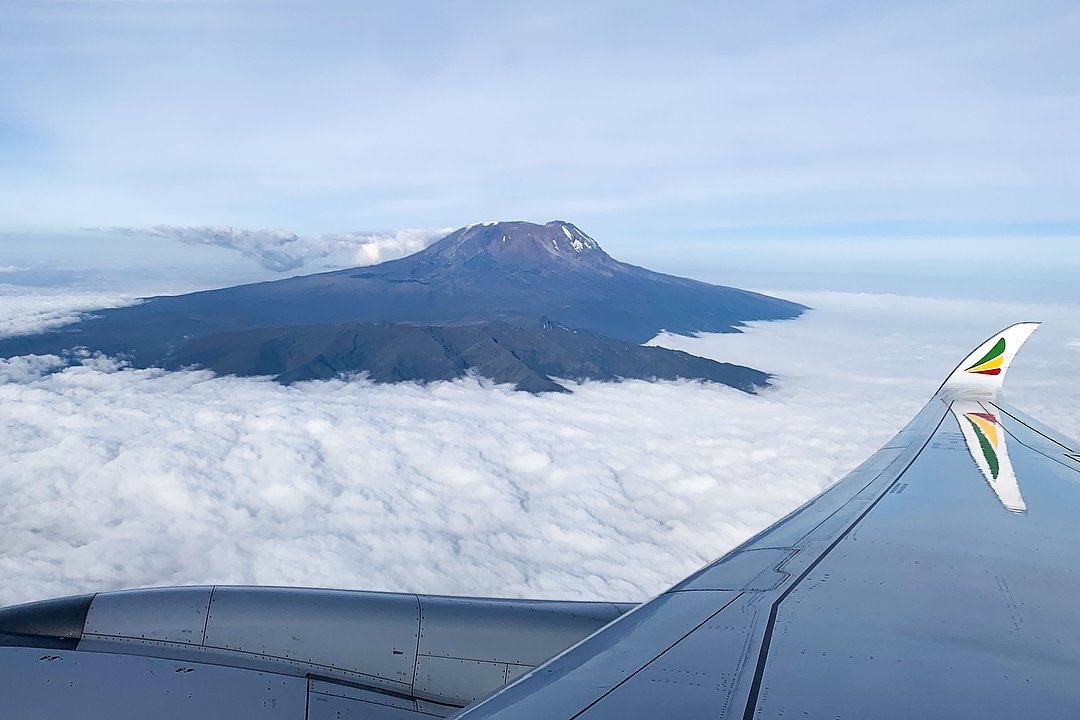
Flying out of Kilimanjaro airport, on my way home through Addis Ababa, I always get a window seat on the right side of the plane. Most of the time I’m then rewarded with a view of Kilimanjaro itself, which I climbed back in 2010. iPhone photo.
Yes, it’s a long trip. And yes, with the travel, heat and rough roads, it can be challenging. But there’s a very good reason I keep returning, and have some people that return with me as well. Simply said, there’s no experience like it on earth. That’s why I’m planning to go once again in 2025 and do the same trip. If you’re interested in joining me, let me know.
(If you like this story, please share it with your friends and let them know about the links on photography that I post on my business Facebook page. I’m also on Instagram and Twitter, @reedhoffmann. And if you’re curious about the workshops I teach, you can find them here. Finally, you can subscribe to this blog on my home page.)

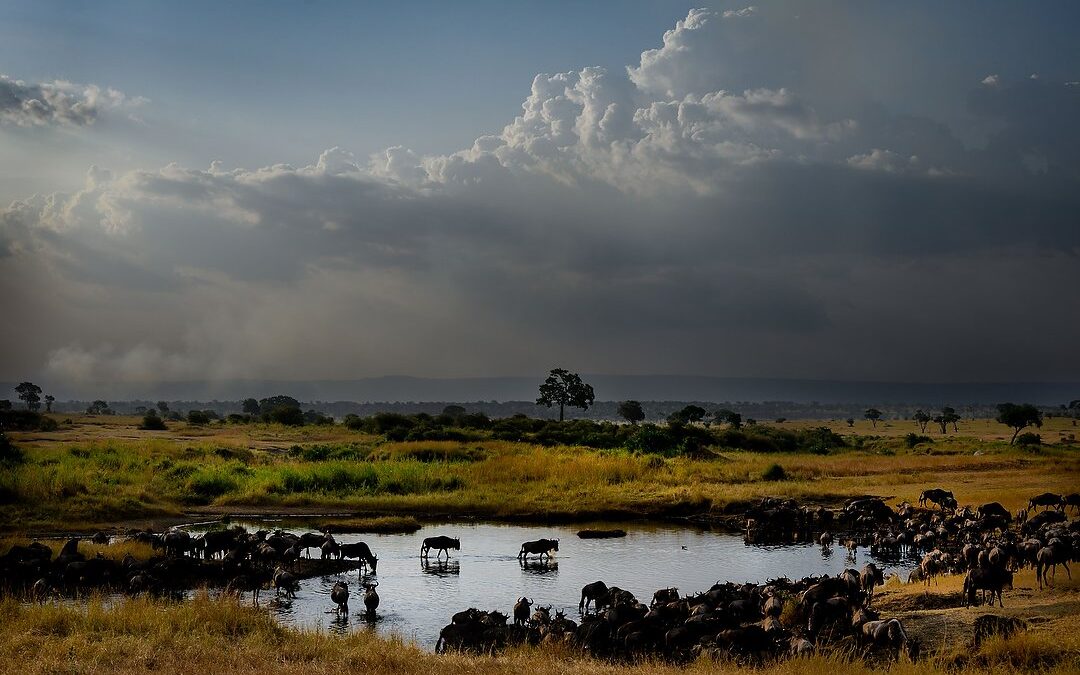
Thanks Reed. Love your storytelling.
Wow and double wow!!!
Reed, great story & photos!